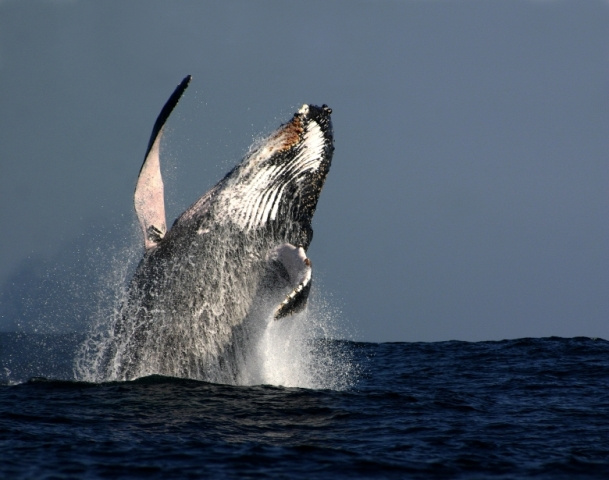Humpback Whale
Humpback Whale (Megaptera novaeangliae) Spanish name: Ballena Jorobada, Jibarte, Yubarta

More about Humpback Whale
Habitat
This whale lives in tropical to polar waters, depending on the season; they may gather into groups close to the shore.
Range
Found in every ocean, the humpback migrates from the poles towards tropical waters in the winter.
Physical Description
With a round, wide body that narrows towards the tail, and a flattened, slender head, the humpback has a characteristic shape. The white lumps on its head and jaw are home to parasites, whale lice (cirripeds), and crustaceans living in the whale's follicles or hairy tubercles. The main body color is black to gray, with lighter skin on the throat and belly and wide ridges along the length of the white skin. The humpback whale has a relatively small dorsal fin, and large flippers that are white on the edges.
Interesting Biology
The humpback can be seen breaching in coastal waters, lunging out of the water and smashing its huge back onto the water. Traveling alone, in small pods, or groups of up to 15 in feeding and breeding waters, these large, distinct whales are always exciting to see. The conspicuous fin and back rise out of the water as the humpback surfaces to breathe. The most acrobatic of the large whales, it bursts into the air with breathtaking energy and speed, even though most of the time it does not swim very fast (12 km/h) and only dives for about 15 minutes at a time.
Humpbacks communicate via sophisticated vocalizations. Since these social whales tend to congregate near coasts, they were especially exposed and devastated by whaling ships before they were declared a protected species in 1964. Unfortunately, whalers are still allowed to kill the humpback off the western coast of Greenland and Lesser Antilles. This large sea acrobat is also vulnerable to attack by killer whales.
Diet
The humpback hunts krill, plankton, and fish (such as cod, capelin, or herring). It captures prey in an interesting way: it circles beneath the shoal, making a ring of bubbles around the prey, causing them to rise slowly towards the surface; once they are surrounded in a net of bubbles, the humpback opens its large mouth and swallows them.
Height/Weight
Reaching a length of 15-17 m, Humpbacks can weigh 24-28 tons; females are somewhat larger.
Brief Taxonomy
Order: Cetacea
Family: Balaenopteridae
Sources
Saenz, Joel C., Grace Wong, and Eduardo Carrillo. Ballenas y delfines de America Central. Instituto Nacional de Biodiversidad. Costa Rica, 2004.
Henderson
-Amy Strieter, Wildlife Writer
Humpback Whale Sightings
Similar Profiles
We believe travel is more than ticking destinations off a list – it’s about discovering new places deeply, feeling connected wherever you go, and knowing you have a trusted team behind you every step of the way.



